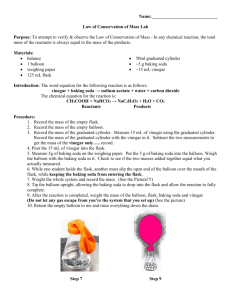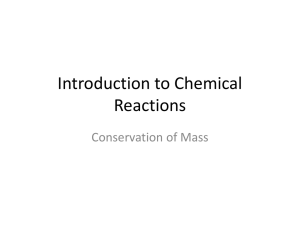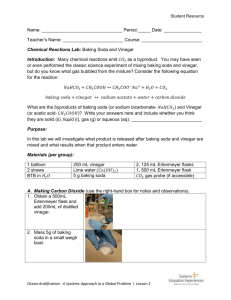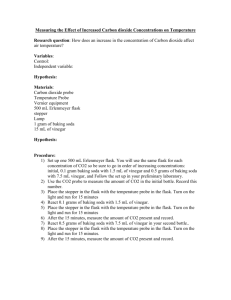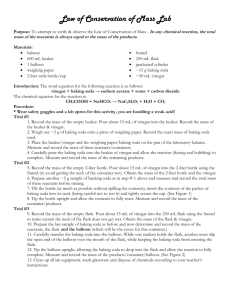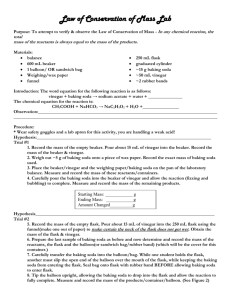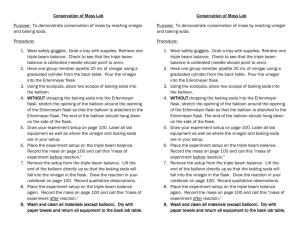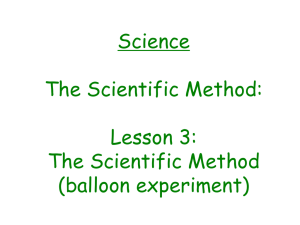OL Conservation of Mass Lab
advertisement
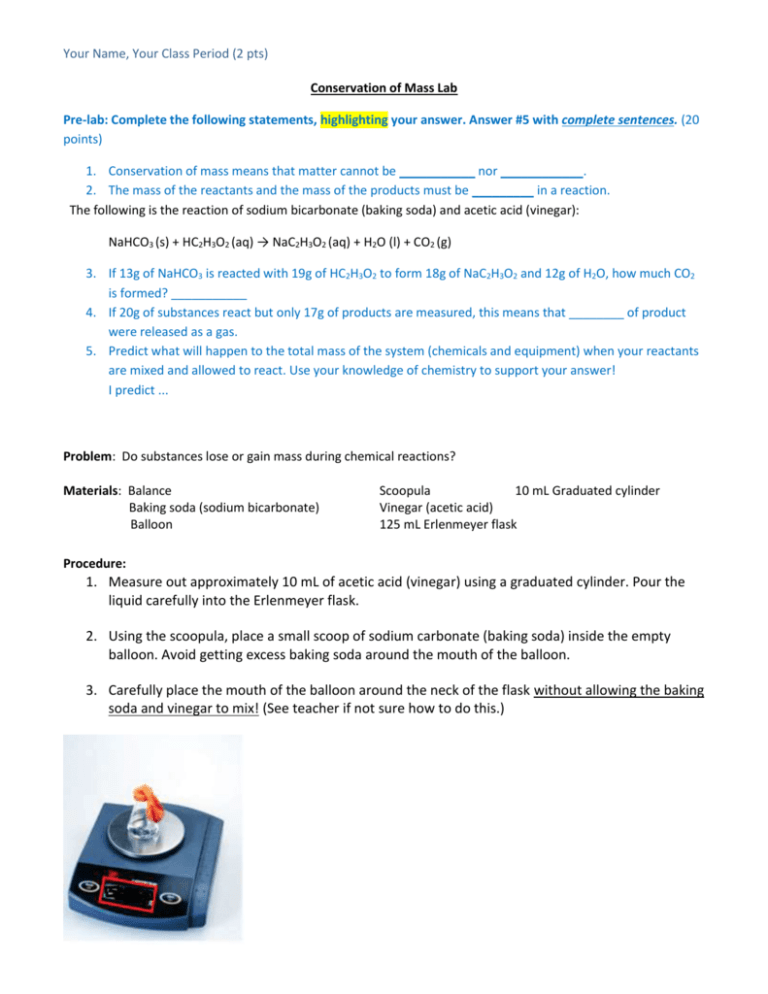
Your Name, Your Class Period (2 pts) Conservation of Mass Lab Pre-lab: Complete the following statements, highlighting your answer. Answer #5 with complete sentences. (20 points) 1. Conservation of mass means that matter cannot be ___________ nor ____________. 2. The mass of the reactants and the mass of the products must be _________ in a reaction. The following is the reaction of sodium bicarbonate (baking soda) and acetic acid (vinegar): NaHCO3 (s) + HC2H3O2 (aq) → NaC2H3O2 (aq) + H2O (l) + CO2 (g) 3. If 13g of NaHCO3 is reacted with 19g of HC2H3O2 to form 18g of NaC2H3O2 and 12g of H2O, how much CO2 is formed? ___________ 4. If 20g of substances react but only 17g of products are measured, this means that ________ of product were released as a gas. 5. Predict what will happen to the total mass of the system (chemicals and equipment) when your reactants are mixed and allowed to react. Use your knowledge of chemistry to support your answer! I predict ... Problem: Do substances lose or gain mass during chemical reactions? Materials: Balance Baking soda (sodium bicarbonate) Balloon Scoopula 10 mL Graduated cylinder Vinegar (acetic acid) 125 mL Erlenmeyer flask Procedure: 1. Measure out approximately 10 mL of acetic acid (vinegar) using a graduated cylinder. Pour the liquid carefully into the Erlenmeyer flask. 2. Using the scoopula, place a small scoop of sodium carbonate (baking soda) inside the empty balloon. Avoid getting excess baking soda around the mouth of the balloon. 3. Carefully place the mouth of the balloon around the neck of the flask without allowing the baking soda and vinegar to mix! (See teacher if not sure how to do this.) Your Name, Your Class Period (2 pts) 4. Mass the entire system (flask with vinegar and balloon attached to mouth of flask). Record this mass as “Initial Mass” in the data table below. 5. With the flask on the lab bench, lift the balloon and shake the baking soda into the vinegar (without removing balloon from neck of flask). What do you observe? Record your observations in the data table below. 6. Place the entire system (flask with attached balloon) AGAIN. Record this mass as “Final Mass” in the data table below. 7. Wait until all changes have completely stopped. Place the flask on the lab bench and SLOWLY remove the balloon from the mouth of the flask. Wait 30 seconds. Place balloon back on neck of flask and find the mass of the system. Record this mass as “Mass After Releasing Gas Products”. 8. Find the difference between “Initial Mass” and “Final Mass” and record it in the table. 9. Find the difference between “Final Mass” and “Mass After Releasing Gas Products” and record it in the table. Data and Observations (18 pts): Initial Mass of the System Observations of the reaction (What did you see? Hear? What changes occurred?) Final Mass of the System Mass After Releasing Gas Products Initial Mass of the System - Final Mass of the system Final Mass of the System - Mass After Releasing Gas Products Your Name, Your Class Period (2 pts) Analysis Questions: Answer the following questions in complete sentences. (30 points) 1. What kind of change (physical or chemical) took place when the sodium bicarbonate (baking soda) was added to the acetic acid (vinegar)? Explain your answer. 2. During a chemical reaction, does the total amount of mass change? Explain your answer. 3. A student performs this experiment and finds that the difference between the initial mass and final mass is 0.20g. How can this student explain the difference in mass? 4. When the student removes the balloon from the flask, an additional 0.50g is lost. Where did this mass go? 5. During a chemical reaction, can the state of matter change? If so, give an example. Conclusion: A Paragraph of Awesomeness (30 pts total) 1. Paragraph: must be written as such (1 pt) 2. Spelling and grammar (1 pt) 3. Complete sentences. (3 pt) Write an expository paragraph using complete sentences and your own words. Include the information listed below. You must correctly use the following ten vocabulary terms in your answers (10 pt): conservation of mass, reactant, product, error, acetic acid, sodium bicarbonate, gas, solid, liquid, chemical. **UNDERLINE THESE TERMS when they appear in your paragraph!! Include the following information in your paragraph. Use the answers to the analysis questions to help you: ● Purpose of the lab ● Procedure ● Explanation of your results ● Error analysis of the lab WRITE YOUR PARAGRAPH BELOW USING COMPLETE SENTENCES, INCLUDING ALL BULLET POINTS, AND INCLUDING ALL UNDERLINED VOCABULARY TERMS.
